Wylliams / Henry Contemporary Dance Company
On The Edge
5, 6 March 2010, The Foundation, 1221 Union (west bottoms), Kansas City, Missouri
Going New, Again
Audience pre show for Saturday - the stitched ultra-wide lenses appears to thin the crowd out - but this was a very full night in the intimate venue.Wylliams Henry is one of the Kansas City area's best dance companies yet after nearly two decades it remains little known locally. As with other companies this economy has made funding more difficult. Wylliams Henry is trying new approaches including new performances, new venues, collaborations and varied programs, including this benefit with abbreviated samples of works, mostly in the company repertoire with some works from contributors.
So what was different? The location in the west bottoms, smaller seating in a first-friday art venue, the rough-hewn and very close performance space, the off-stage performance of a work pre-show and during intermission, abbreviated versions of most of the works, and a DJ dance party after (although no one was dancing).
Essentially it was a sampler evening, including a sampler video (more later), designed to show a range of work fairly quickly, mostly to patrons and funders. So how did it come off? No one seemed disappointed and a foot was put into the waters of experimental performance.
Because the purpose was not just to put on a show, a review from the outside probably doesn't see what was gained, or learned, or even what worked. And although I worked within the show (video and stills) I can't say I have any great revelations. But I do think it was productive in terms of breaking out of a two-per-year major concerts at White Recital Hall and I think it was productive in getting information about how to look for funding and how to look for new audiences in a tight-funding climate. Unlike another reviewer who thought the show was "vapid" and didn't get out of the box, my own view is that this show broke a lot of ground, much of which was in the background and not obvious. I think it is an important step for a company which greatly deserves much more attention that it has gotten.
The seating was far less than at White Hall but it filled up with what seemed to me eager crowds on both nights. I'm guessing at 120 or 130 the first night with a few people standing or on the floor and maybe 150 the second night, after adding seats and still a few people were standing or on the floor.
Quick Rundown - The Show:
Most of the pieces were short, abbreviated versions or selections from larger numbers. Laddertime was a sort of appetizer or side show with two male dancers (Eric Sobbe and Michael Tomlinson) performing low-altitude acrobatics. It definitely focused attention before the show and during intermission. Friday the ladder was at the north end of the space, off the audience. Saturday the ladder was moved to near the entrance.
In addition a video sampler of past Wylliams/Henry work was projected on a screen at the back of the "stage" area. I prepared this video (details below). I was actually a little surprised at the amount of interest in watching this. When I put the compilation together I just assumed this would be part of the background and not particularly noticed.
"Ladders" top: Mike Tomlinson, bottom: Eric Sobbe
Laddertime
Pre-show and intermission performance
Movement with Eric Sobbe and Michael Tomlinson with Paula Weber
Music: Kronos Quartet
Ritual
Choreography: Amber Perkins
Music: Arvo Part
Costume Design: Antonia Ford Roberts
Dancers: DeeAnna Hiett, Gavin Stewart
2126 in a Series
Choreography: Susan Warden
Music: Original score by James Mobberley
Costume Design: Susan Warden
Dancers: Chloe Abel, Christina Mowrey, Kelanie Murphy
Narrator: John Lewis2126 in a Series is Susan Warden's clever and funny take on romance novels using a three women in teddies in a slumber party, reciting lines from romance novels, as if they are young girls absorbing themselves in the cheesy lines and even cheesier excitement of these stories. The fun is in the words and in particular the young-girl delivery of the lines. The dancing keeps it moving and brings the women into fresh poses as they recite, in breathy, dramatic voices the book the group is "reading."
It needs a deft touch, something Warden is good at, social comedy, or it could be an eye-roller. These three dancers did the job and the audience did the laughs.
Puppet Gamelan
Choreography: Tiffany Loney
Music: SPK
Costume Design: Paula Weber
Dancers: Kelanie Murphy, Michael Tomlinson
Trap Door Party Excerpt #4
Choreography: Josh Beamish
Composer: Aphex Twin
Music: Alarm Will Sound
Lighting Design: Josh Beamish
Costume Design: Josh Beamish
Costume Construction: American Apparel
Dancers: Christina Mowrey, Christopher Barksdale, Chloe AbelThis excerpt from Josh Beamish's Trap Door Party performed in the Fall 2009 Wylliams/Henry concert was the part which was dropped from the piece because the props, the suspenders, kept snapping off the trousers. Now, with suspenders working, this tiny excerpt from the larger piece has Chris Barksdale finally getting his chance to have the two women partners play with his suspenders, and this time they stayed on. In Fall it was Chris, with Christina Mowrey (who was in this performance) and Tracey Franklin (not available for this show) which was covered in the Edge performance by Chloe Abel.
Eden - DeeAnna Hiett and Gavin Stewart
Eden
Choreography: DeeAnna Hiett and Sabrina Madison-Canon
Music: Kronos Quartet
Costume Design: Laura Powell
Dancers: DeeAnna Hiett, Gavin StewartEden was like a continuation of Ritual. The same two dancers and a similar kind of sinewy set of movements in the duet. This time the lighting worked strongly on adding shadows to accompany the dancers, in several directions at once.
Butterbeans and Susie at the Apollo
Choreography / Staging: Mary Pat Henry
Vocal and Music Coach: Gavin Stewart
Musician: Gavin Stewart
Costumes: Mary Pat Henry
Costume Construction: From The Archives, Kathy Bradford
Dancers: Christina Burton, Christopher Barksdale
Susie (Hawthorne) Edwards and Jodie Edwards - as Butterbeans (Jodie) and SusieThis is a piece Mary Pat Henry has been meaning to do for some time and it was a hit. This is a recreation of a long-time act by two performers whose shtick was domestic humor with often risque and downright bawdy dialog. The pair originally toured with the Theater Owner's Booking Association (TOBA, also refered to as Tough On Black Asses) which kept black performers employed, though usually for less money and under less favorable conditions than the white vaudeville circuit. Reference: http://en.wikipedia.org/wiki/Butterbeans_and_Susie
Christina Burton and Christopoher Barksdale as Butterbeans and Susie (from video capture)Chris Barksdale performed as Butterbeans and Christina Burton (2008 UMKC dance graduate) portrayed Susie.
The pair performed the B&S number "I Want a Hot Dog for My Roll"
I want a hot dog without bread you see.
'Cause I carry my bread with me.
. . .
I want it hot, I don't want it cold.
I want it so it fit my roll.
Christina Burton and Christopoher Barksdale as Butterbeans and Susie (from video capture)Burton is one of those multiple threats, great as dancer and as singer. She has the physical heft and gutsiness to carry off a big mama routine and the dance talent to sell it as well as an operatic voice which does pop just as well. They are both a couple of my personal-favorite performers. Together Burton and Barskdale brought gusto to the too-brief piece.
no place, good place - Christina Mowrey (front) and Michael Tomlinson and Chloe Abel
no place, no good
Choreography: Tiffany Sisemore
Music: Mum
Costume Construction: American Apparel
Dancers: Chloe Abel, Christina Mowrey, Michael Tomlinson
Tumescence
Choreography: Tiffany Sisemore
Music: Tom Waits
Costumes: Tiffany Sisemore
Dancers: Gavin Stewart, Kaely Tieri
Sweet Otis Suite
Choreography: Mary Pat Henry
Music: Otis Redding
Lighting Design: E.J. Reinagel
Costume Design: Kate Mincer
Costume Construction: Laura Powell
Dancers: Chloe Abel, DeeAnna Hiett, Torens Johnson, Christina Mowrey, Gavin Stewart, Rodni WilliamsThe Sweet Otis Suite excerpt is one of the pieces which I think did suffer from the ungainly staging arrangement. The "Shake" segment of the suite was originally designed for four couples and the brief excerpt used three couples. Ordinarily this would have worked all right except for the column in the middle of the stage. There was just no way to arrange spacing which managed to balance every one.
Mary Pat has staged the full suite twice so far in the two main concerts yearly, introducing it in the 2007 September concert and using it again in 2009 September. It is always a house raising feel-good piece based on the music of Otis Redding. It was a good choice for an end piece, even as an excerpt, but the spacing weakened the piece. It seemed a bit off kilter as if the dancers were trying to dodge the central column. With an extra pair they might have been able to work two on a side.
Audience Reactions
Saturday was the first time I had a good chance to observer audience reactions. There was no audience at dress and on Friday I was too busy figuring out what I would do for video the next night.
I've shot Tiffany Sisemore's Tumescence in performance at least a couple of times before, summer 2008 at City in Motion and a year ago at Modern Night at the Folly. So I am well aquainted with the piece. Kaely Tieri has been in each piece I've seen, first as the protagonist and after as the recipient.
Tumescence is a cute piece with increasing sexual innuendo and play, ending with a furious assault by a paper party toy which unfurls as you blow into it. Gavin Stewart blew into it, it unfurled, directly onto Kaely Tieri. Friday it got a number of laughs and Saturday it sounded as though people were rolling on the floor laughing. Clearly they caught not only the simple silliness, and teasing fun in the character's relationship, but also the double entendres in the action.
Getting To The Performance
There were a few un-expected problems, most caused by the unusual venue in a rough space with a rougher floor and no heat during the early setup. The Marley over the floor refused to lay down properly because of the cold. Even when the Marley, which is just a thick plastic sheet, did eventually lay down it covered the floor complete with raises, bumps and depressions. The uncovered floor had space between the timbers which showed the floor below. Clearly this space was never originally intended as a stage, and especially not for dance. These are old industrial buildings in the west bottoms. As such they are also a reminder of the benefits of even the simplest stage. I was amazed that Quixotic had it booked for the next weekend, although they have a lot of overlapping performances which utilize small side areas anyway.
Originally I was going to shoot video for dress on thursday when I could place the cameras wherever I wanted, not having to worry about being a distraction for an audience. The dancers had to get used to the uneven floor. It could easily cause injury. DeeAnna Hiett who had suffered knee injuries in performance twice before felt she could not go all out during dress. Injury is always a threat to dancers and uneven floors are career-threatening hazards.
Two years ago (May 2008) performing a duet in "The City" by Jennifer Muller, DeeAnna tore a meniscus in the same knee, in which five years before that, she tore her anterior cruciate ligament. Hiett is a mainstay of the Wylliams Henry company and those injuries cost heavily both for her personally and for the company. In that performance two years ago it meant canceling the company's entire last show. Hiett herself was more than a year before she returned to a concert performance with Wylliams/Henry (Fall 2009).
When I tried to figure out the best time to shoot video, aiming for the optimal performance we decided I should also skip Friday and wait for the Saturday performance. By then they would be more used to the floor and other obstacles, such as the huge column in the center of the performance area.
It is a space to work around, but with the columns, hardly an open stage, despite not being closed off by a stage apron or proscenium. For audiences and art go-ers it is a throw back to more Bohemian pleasures in old lofts and other forgotten but inexpensive spaces while, for a working dancer, are just injury hazards.
It didn't help the video that because of the floor and the need for the dancers both to adapt to the uneven surface and to avoid injury that we couldn't do the full video for dress, when camera placement could be anywhere it would work well. Shooting during a performance with an audience usually means stying out of sight as far as possible.
In a regular theater that usually means back of the house, three-quarters back or even in the lighting / sound booth and generally at line-of-sight level for use later in recording and re-setting the piece. Here, in The Foundation it meant hiding one camera off to the right (stage right "wing" behind a rectangular panel) about two-feet above the floor and the other cameras behind the seats to the left and on top of a piece of wood sitting on a portable bar. The small forest of tripods looked like an old newsreel camera arrangement on top of a van in the streets.
I had originally wanted to shoot from closer on both cameras and with three cameras spaced along the stage area. But that was out of the question. The unusual arrangement also meant that I wound up working the video projector. I had originally been asked to throw together some clips of works which could be projected. How to do it was vague but became clear after some work.
The projector was borrowed from the Dolphin Gallery and because it would do HDMI among a ton of other inputs I could bring a separate DVD upscaling projector. I wound up putting the projector on a step ladder and taping it down. The first night was a bit dis-jointed with me running to put the lens cover and place it on or off (I was afraid to shut it down fearing the lamp would give problems and knowing it takes a while to shut down and then turn on again).
By Saturday, as I stood atop the portable bar like one of those early newsreel camera operators, I could just reach over and pop the lens cover on or off from the projector. More interesting to me was what the sampler video showed about Wylliams / Henry. Even though these all came from video I had archived over the last several years working with Wylliams / Henry, some of it my shooting and some of it earlier shooting captured from VHS, Digital Eight and Hi-Eight, this was something I had never really put together in one collection.
As I watched what I had put together it really began to sink in what a large range of work this company has done. I should note there were a lot of pieces which didn't get into the sampler just because I didn't have the time, such as Nocturne (a topless solo in dark blue light), Soireee (a party goes on as the Nazis gain power) and many more. This is really a strong body of work. I think the audience also managed to see pieces they either didn't know about or remembered but usually just a few at a time.
Most of us who work a show more than one night know it changes nightly, especially so in the early part of a run or during a change. That really affects photography because usually both light temperature (color balance) and light amount change, so for all the notes I take in rehearsal to prepare for an actual performance shoot I am still only partially prepared. I have to watch out for surprises, mostly in the amount of light available.
These are almost never designed for camera. If it were I could be first in the food chain with a single setting for the cameras and all the lighting would have to fit within that one setting. All adjustments would be done by watching a television hooked to the camera. As it normally is, anyone on camera, by necessity, has to work to defeat the lighting director in order to have something which 1) is visible and 2) somewhat resembles the lighting director's intentions for the way it looks to an audience's naked eyes. So it if goes dark the camera has to open up and if it goes light the camera has to close down, all a step or two behind the actual light changes. If the filtration changes the camera is normally just SOL because there are not enough presets in the world to account to stage filters.
In order to go darker on set, most lighting people just dim the lights. That means that people dark adjust so the lights have to go still dimmer making it ever tougher for a camera to follow and keep a clean image. The best way to get a solid dark is to have a solid light. Put intense light somewhere on set and eyes will bright-adjust so that the darker area becomes very opaque.
The other problem I see (pun un-intended but retained) with low light is that funders are often at a disadvantage visually in the dark and can't see enough to reach for their wallets. (okay, yes, I am being clever, but it is also true)
In addition to my usual complaint about lighting which is too low for my cameras, I also have my usual plea for more explanation in the program about each piece. Two of the pieces have explanation but it would have helped to do the same for the other pieces, especially Gamelan, because the story is generally inferable but a few specifics would clarify the roles of the characters (mother and daughter). I seldom read much exposition in any dance programs, but it would really help. My general concept is that the more the audience understands ahead of time about the concept, the narrative, of any dance, the more they see and the less which escapes them.
Michael Tomlinson (top) and Kelanie Murphy in Puppet Gamelan
|
Puppet Gamelan was a problem for me photographically. It was the darkest piece, hard to see even with human eyes, almost impossible for a camera. I came in on Thursday to determine when to shoot and because I really hate to go in cold. Dress gives me a chance to see what is coming up and to shoot a number of stills, both for themselves and to help me determine settings for video. As it turned out dress rehearsal was the only chance to get any number of decent shots from Puppet Gamelan in performance. Even so the very low light totally messed with my focus. Autofocus just wouldn't work at all. Eventually I decided to go back to my starting days in the 60's and estimate focus by eye then set a manual focus on the lens. Ironically, all the advanced digital designs made this a tricky, tough task. Manual focus by estimating distance was much easier to do in the old days when lenses had decent focusing scales on the outside of the lenses. So I muffed a lot of otherwise good shots at the beginning for truly terrible focus and managed to get a few shots toward the last part of the piece, which looked better only after post processing. Focus itself was limited to a couple of inches at best in depth of field shooting with a 3200 ISO at F/2 and a 30th or less on a 35mm fixed lens. No wiggle room. The next night, Friday, I utilized the performance to look for changes and to use one of the video cameras in order to derive starting settings for the video shoot on Saturday. This time Gamelan was really very, very dark and the few attempts to get shots were not worth the time, even knowing ahead that I would have to manually focus. When Saturday came around I was too busy with video to bother taking any time for stills even though the lighting was brighter than at dress and much more amenable to shooting though still too dark for truly pretty camera results. At least I could get something with the Sony's which I could pump up a bit in post processing. Indeed, because friday's extra dark light levels had so worried me, I told Mary Pat that this piece might be a wash, with nothing usable in video. So, I also brought along one of my old amateur cameras with "Night Shot" (IR), as a worst-case camera. That did produce more picture, though nothing pretty, just more usable if you were re-setting the piece using the video to guide you. |
Break between pieces in the second half - bottom left: Mary
Pat Henry, just above her, Paula Weber and Tiffany Sisemore
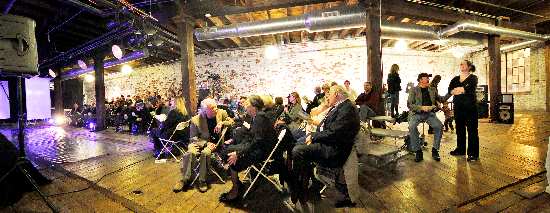
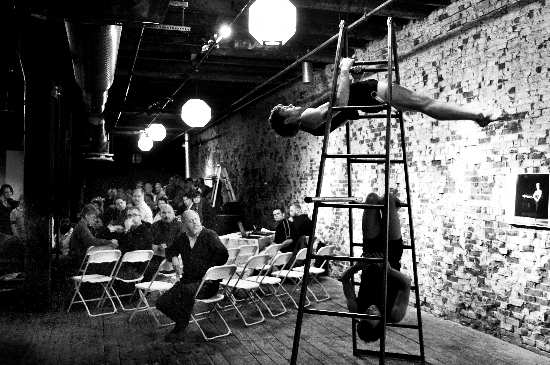
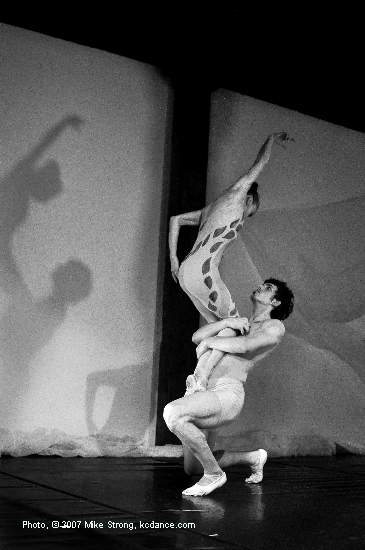
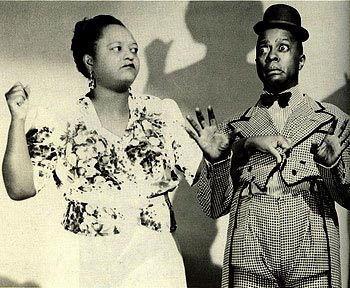


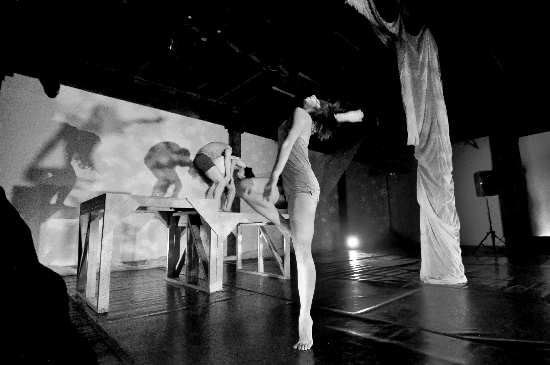

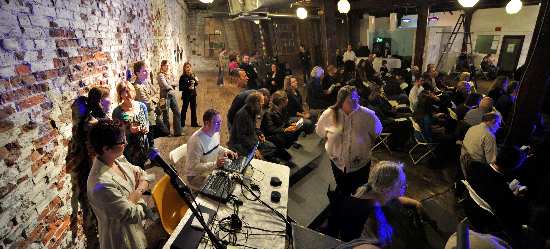
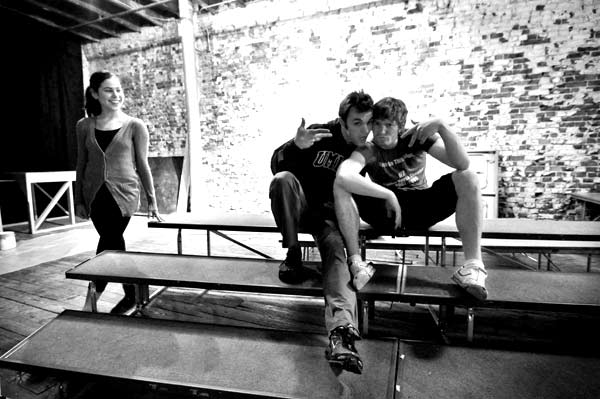
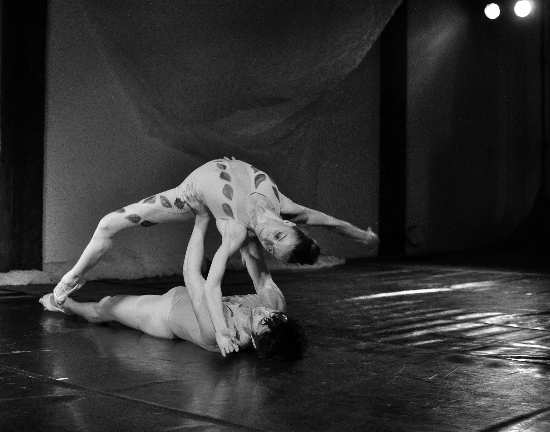
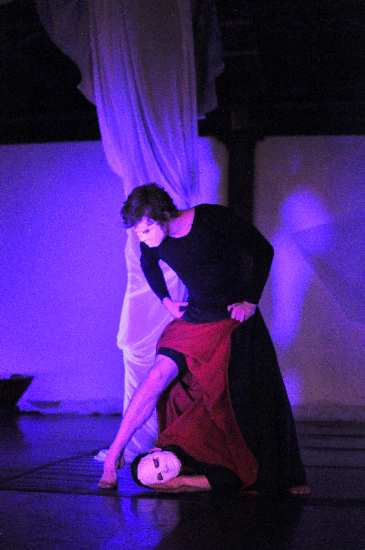
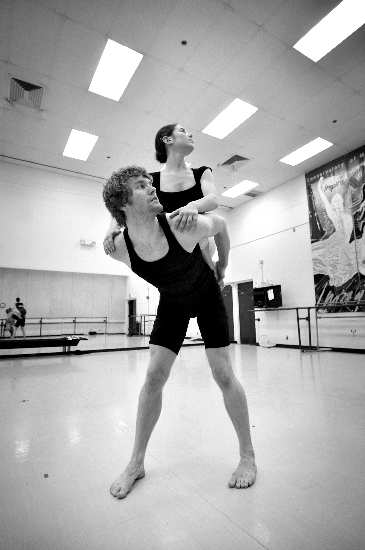
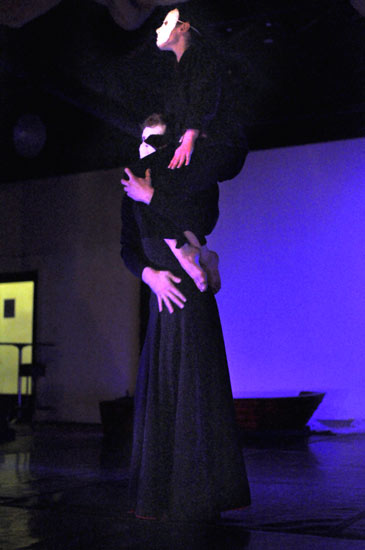
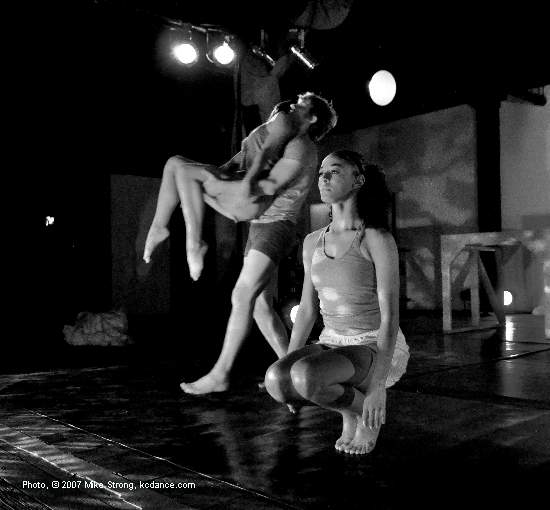
 Email This Page
Email This Page